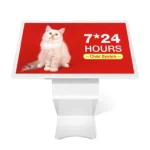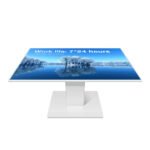Does Digital Elevate the Retail Window Display?
The retail window display has always been the silent, yet most persuasive, salesperson for any physical store. For centuries, it has served as the critical interface between the brand and the passing shopper, a static canvas designed to momentarily stop foot traffic. However, in our current fast-paced, digital-first world, traditional static displays are increasingly struggling to capture the attention of an increasingly screen-savvy audience. Consequently, a profound evolution is underway, driven by the integration of digital signage, specifically focusing on high-brightness digital retail window display technology.
This article delves into the indispensable role digital transformation plays in modern window merchandising, providing concrete value to those operating and utilizing digital signage products. It seeks to answer whether the incorporation of digital elements truly elevates the effectiveness and ROI of this crucial marketing asset, particularly in attracting the modern consumer.

The Foundational Role of the Retail Window Display in Modern Commerce
At its core, the primary function of the retail window display remains unchanged: to tell a compelling story and translate curiosity into store entry. It’s an immediate, high-impact marketing moment that defines a brand’s aesthetic and current offering. In dense urban retail environments where businesses vie for fleeting attention, the quality and dynamism of the window directly correlate with traffic conversion.
Historically, this required skilled visual merchandisers to manually craft elaborate, high-cost, and low-flexibility installations. While charming, these static setups lack the immediate responsiveness and data-driven agility required in contemporary marketing. Now, with the advent of specialized digital displays—characterized by extreme luminosity, often rated at 2500 nits or higher—this limitation is being comprehensively addressed. These high-brightness screens are specifically engineered to cut through direct sunlight, ensuring that the brand’s message is vivid, legible, and impactful, regardless of the time of day or weather conditions. This fundamental shift marks the window’s transformation from a static painting to a dynamic, always-on broadcasting platform.
The Digital Advantage: Revolutionizing Engagement and Adaptability
The integration of digital signage into the retail window display introduces a paradigm shift in two key areas: engagement and adaptability.

Enhancing Engagement with Motion and Color
The human eye is naturally drawn to movement and contrast. Unlike a static poster, a digital retail window display can leverage high-definition video, compelling animations, and instant content changes to create a far more captivating visual hook. Consider, for example, a luxury brand utilizing a large-format display to run a visually rich, short-form fashion film, or a quick-service restaurant broadcasting a time-sensitive, rotating menu with mouth-watering video clips. This dynamic capability allows for richer storytelling that evokes emotion and significantly increases dwell time among passersby. Furthermore, the theme color for this digital revolution is undeniably vibrant white and high-contrast hues, optimized to maximize visibility and brand impact under challenging lighting conditions.
Achieving Agility Through Content Adaptability
Perhaps the most significant business advantage offered by digital windows is their unparalleled content agility. Traditional displays might take days or weeks to conceive, install, and dismantle; by contrast, digital content can be updated remotely and instantaneously. This allows retailers to:
- Implement Dayparting: Run different promotions or messages based on the hour of the day (e.g., a coffee special in the morning, a dinner promotion in the evening).
- Respond to Real-Time Events: Instantly update promotions to align with local weather, spontaneous sales, or inventory levels without incurring physical production costs.
- A/B Test Visuals: Quickly test two different creative concepts—such as varying color schemes or call-to-action placements—to determine which drives higher conversion, gathering immediate, actionable data.
This level of responsive marketing is impossible to achieve with traditional physical merchandising.

Strategic Deployment for the Digital Signage User
For digital signage product users and providers, the successful implementation of a digital retail window display system depends critically on strategic hardware and software selection.
Firstly, hardware specification is paramount. Since these screens are often placed behind glass, facing significant thermal load and direct sunlight, specialized commercial-grade high-brightness displays are non-negotiable. Standard consumer televisions are simply not built to withstand the heat and continuous 24/7 operational requirements of this environment. Users must select panels with robust cooling systems, tempered glass, and luminosity outputs necessary to dominate the surrounding light environment.
Secondly, the content management system (CMS) must be simple, powerful, and integrated. A successful digital window strategy requires a CMS that can handle scheduling, zoning (dividing the screen for multiple pieces of content), and remote diagnostics. This ensures that a single team can efficiently manage hundreds of displays across multiple locations from a central hub, minimizing operational costs and maximizing content relevance.
Furthermore, integrating the display with in-store and online data sources is the next frontier. Imagine a digital window displaying a specific product and, simultaneously, showing a real-time count of how many pieces of that item are left in stock, or a live feed of positive social media mentions. This level of transparency and urgency significantly enhances the perceived value and spurs immediate purchase decisions.
Navigating Challenges and Ensuring Best Practices
While the benefits are substantial, certain technical and creative challenges must be effectively managed. The primary technical hurdle involves heat dissipation and light reflection. Proper installation must account for necessary airflow around the unit to prevent overheating, which can drastically reduce the screen’s lifespan. Anti-reflective coatings on the glass or the display itself can also be critical to maintaining picture clarity.
Creatively, the transition from static to dynamic content requires a shift in design philosophy. Content should be concise, high-contrast, and fast-paced, designed for fleeting attention spans. It’s important to avoid excessively busy or text-heavy screens, which can overwhelm the viewer. The goal is to deliver one clear, impactful message in a matter of seconds, compelling the shopper to step inside. The digital retail window display should serve as a digital beacon, drawing customers in through its sheer presence and vibrancy.
Conclusion: The Future of the Retail Window Display is Luminescent
The question, “Does digital elevate the retail window display?” is definitively answered with a resounding yes. The integration of high-brightness digital signage technology is not merely an optional upgrade; it is a fundamental shift that empowers retailers to be more agile, more engaging, and ultimately, more profitable. By replacing static limitations with dynamic capabilities, the window transforms from a passive poster into an active, measurable, and highly responsive marketing channel. Retailers focusing on digital displays for their windows are investing in an essential tool for communicating with the modern, connected consumer, ensuring their storefront remains a vibrant and effective first point of contact. This digital evolution secures the window display’s legacy as the most powerful visual asset in physical retail.
Frequently Asked Questions (FAQ)
Q: What is the minimum recommended brightness (nits) for a digital retail window display?
A: To effectively compete with direct sunlight, especially in south-facing windows, a minimum of 2,500 nits is generally recommended. Displays rated at 3,000 to 5,000 nits offer superior visibility and color saturation in bright conditions, making the content far more impactful and legible.
Q: Can standard consumer TVs be used for digital retail window displays?
A: No. Standard consumer TVs are not built for continuous (24/7) operation, lack the required high-brightness (nits) output, and do not have the specialized cooling systems needed to withstand the significant heat buildup that occurs when placed behind a window in direct sunlight. Using them will quickly lead to premature failure and display blackening.
Q: How often should I change the content on my digital window display
A: The frequency depends on the retail environment and campaign. For maximum engagement, content should be updated at least once per day (using dayparting for different times), and major campaign visuals should be refreshed weekly or bi-weekly. The main advantage is the ability to change it instantly based on performance data or current needs.




